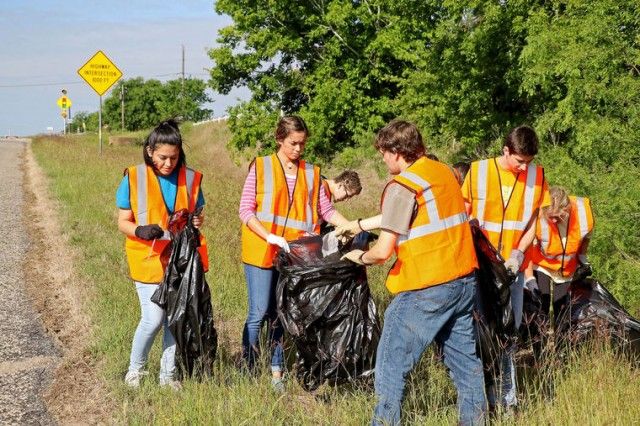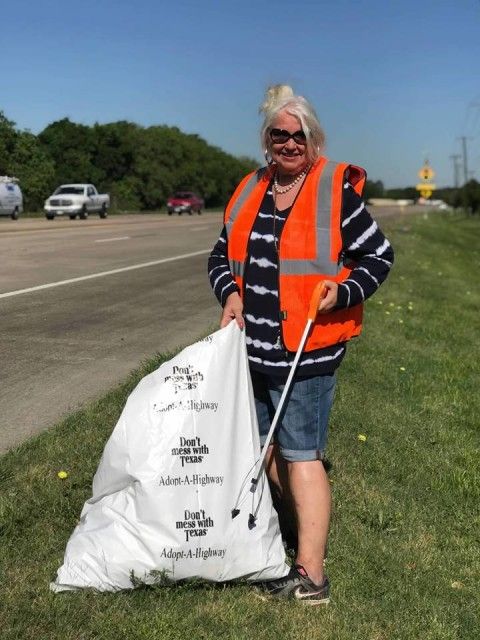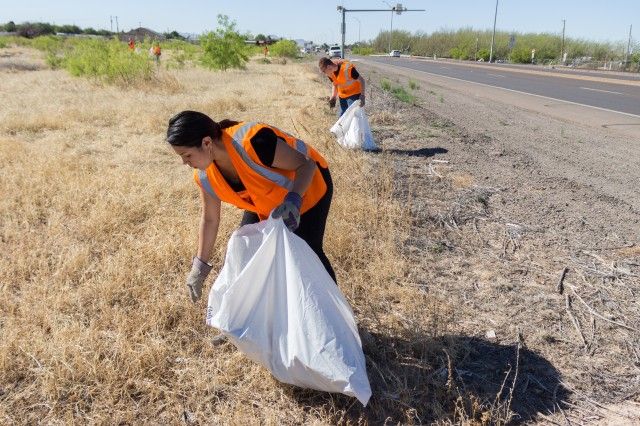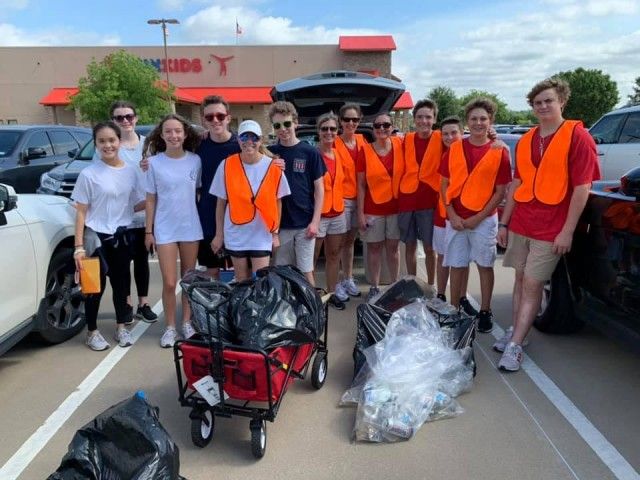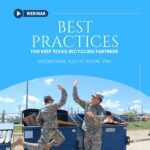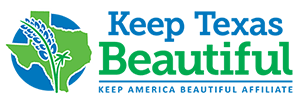Keep Texas Beautiful and the Texas Department of Transportation (TxDOT) first began working together in the late 1960s. They shared the common goal of making Texas roadways attractive and safe for motorists, which has remained a priority for over 40 years. Since 1985, Keep Texas Beautiful has partnered through an annual contract with the Texas Department of Transportation to support TxDOT’s anti-litter and beautification programs, such as the Don’t mess with Texas Trash-Off.
TxDOT Adopt-a-Highway Program & Don’t Mess with Texas Trash-Off
The Texas Adopt-a-Highway program, which is the premier litter prevention campaign of the Texas Department of Transportation. It began in 1985 when the Tyler Civitan Club adopted a two-mile stretch of Highway 69. Adopt-a-Highway currently has more than 3,800 participating groups across the state, saving the state $3+ million a year in litter pickup. Adopting a piece of Texas highway is simple! You agree to take charge of a two-mile stretch of road for a minimum of two years; and once approved, you agree to clean your portion of the highway at least four times per year. The Adopt-a-Highway program will post signs with your group’s name along your adopted section of road, and will provide volunteers with safety vests, litter bags and the appropriate training. (Please note, Adopt-A-Highway is managed by the Texas Department of Transportation and not KTB.)
Interested in adopting a stretch of TxDOT highway? Check out the resources below to get you started.
- TxDOT Adopt-a-Highway Coordinator List
- Adopt-a-Highway FAQ
- Adopt-a-Highway Application
Another TxDOT signature program is the Don’t Mess with Texas Trash-Off. This program also started in 1985 and featured a one day, roadside cleanup extravaganza. It was created as the state of Texas’ signature event for the Great American Cleanup. Administered by KTB, this program was later expanded to include the entire month of April and is now scheduled to become a year-round program. Everyone loves using the TxDOT Don’t Mess with Texas branding and now you can use it all year long for your roadside cleanup activities. Stay tuned for more information and visit our Don’t Mess with Texas Trash-Off page to view tools and resources related to the program.
Tips for a Safe Roadside Cleanup
Whether you are cleaning your TxDOT Adopt-a-Highway, your community Adopt-a-Spot or just planning a roadside cleanup in general, make sure you are keeping your volunteers safe. Any activity along the side of the road can pose dangers, and we have included some great tips and advice for making it as safe as possible. You can also view the TxDOT safety video or access their printable tips card.
Proper Attire
- Volunteers should wear safety vests at all times during the cleanup. Vest should be a bright color with reflective panels.
- Volunteers should wear gloves to protect hands from sharp objects. Leather work gloves are suggested.
- Volunteers should wear closed-toed shoes. Leather shoes or boots with good soles are recommended.
- Wear light-colored clothing and long pants or jeans. Wear a hat and long sleeves to avoid sunburn.
Highway Safety
- When available, use traffic control signs to alert drivers that volunteers are present.
- Consider holding your meet/check-in area in a parking lot or field where you can interact with your volunteers away from the road.
- Carpool to the pickup site to reduce the number of vehicles in the right of way.
- Do not stop or park vehicles on roadways.
- Stay in the right of way. Only cross the roadway when necessary.
- Groups should keep 5 feet of distance from the pavement edge.
- Always work facing traffic. Never turn your back to oncoming cars. If you can see an out-of-control vehicle coming your way, it might be possible to avoid danger.
- All children must be supervised. The suggested ratio is at least one supervisor for every three children under age 15.
- Never walk on guardrails, and do not lean over bridge railings.
- Do not pick up items on bridges, in tunnels or on overpasses.
- Watch your footing. Stay off of/away from steep slopes, trenches or any type of drop-off.
- Avoid using headsets, which can prevent you from hearing oncoming traffic.
- Do not enter the roadway or its shoulder areas to pick up trash.
Health Concerns
- Do not pick up anything that could be hazardous to your health. This includes needles, syringes, jagged glass, animal carcasses, urine bottles or heavy objects.
- It is recommended to have a first-aid kit on hand at all times.
- It is suggested that one or two of the volunteers should be familiar with CPR and general first-aid techniques in case of an emergency.
- Make sure at least one person in each group has a cell phone and the coordinator’s contact information in case of an emergency.
- Keep a list of any allergies volunteers have, in case of an emergency.
- Sunscreen and insect repellent are good to keep on hand.
- Avoid overexertion. Drink plenty of water. Drinking water should be available to volunteers at all times.
Wrapping up Your Event
Once your cleanup is over, make sure you understand where to leave the collected litter for disposal. Smaller groups might be responsible for taking their own litter to a nearby dumpster. If this is a TxDOT Adopt-a-Highway event, you will need to contact your TxDOT coordinator to schedule a pickup and receive instructions on where to leave your bags. If your event is non-TxDOT, consider partnering with your local waste hauler, solid waste, or parks department for their assistance in disposing of collected litter. You might even consider having them as part of your event. Workers driving up and down your route can easily pick up full bags and larger items and even offer water and extra supplies to volunteers. Whatever your plan, make sure volunteers understand where and how to correctly dispose of the items they are collecting and don’t forget the option to provide clear or different colored bags for separate recyclable collection.
Great job with your cleanup! Don’t forget that the data you collect is valuable to KTB, TxDOT, and other agencies that can use the information to secure sponsors and grant funding and even influence legislation. Data can paint a picture of the impact your organization is having on the community and support needs you might want to bring before your local decision-makers. Whether you share the information with KTB, TxDOT, or your local partners, be sure to collect information on the following topics:
- How many volunteers participated? How many were of youth age? Any college students?
- How long did the group work? The current value of a volunteer hour is $ 27.20. That can help present powerful savings to your local government and partners.
- How much did they collect? Be as accurate as possible. Did you count how many bags? Did you have a dumpster that was weighed?
- How far did they go? How many miles of Texas roadway did they clean?
We hope these tips and information are helpful and encourage you to start cleaning up your local highways and byways. Roadside litter is unsightly, but the wind and rain can also carry it further into your community and create further problems. Studies show that a clean area discourages folks from littering and an area with existing litter makes them think one more piece doesn’t matter. Keep our highways and roadsides clean to encourage positive behavior and give citizens an extra push when they see your volunteers working hard on our roadways to keep Texas beautiful! For more information visit us at www.ktb.org and our friends at TxDOT at www.txdot.gov.
Blog post written by Karen Maldonado, KTB Project Manager.
